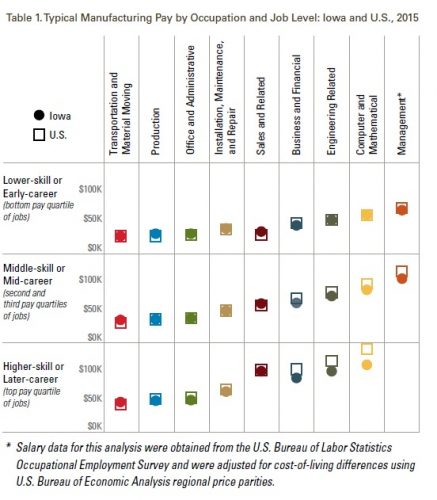
ISU Economist
Liesl Eathington
Assuming that pay levels are commensurate with skills and experience, we apply wage distribution data to create three skill groupings within each occupation. Jobs in the lowest pay quartile represent lower-skill or early-career jobs. Jobs in the highest pay quartile represent high-skill or later-career jobs. Jobs with wages between the 25th and 75th percentile represent middle-skill or mid-career jobs.
Table 1 compares the midpoints of pay ranges for Iowa and U.S. manufacturing jobs within each occupation-by-skill group after adjusting for cost-of-living differences.
For lower-level manufacturing jobs, Iowa exceeds typical U.S. pay levels in several categories. Production, sales, maintenance-related, and transportation-related positions pay 10 percent or more than the U.S. benchmark. Salaries for lower-level office and administrative roles exceed the national benchmark by more than 5 percent.
Iowa’s salaries for the lowest tier of engineering and computer and mathematical positions are very near national values. For management and business and financial positions,
however, Iowa’s lower-level positions pay about 95 percent of comparable U.S. values.
Middle-skill/Middle-career Jobs
For mid-level manufacturing jobs, we begin to see a divergence between occupation groups requiring lower versus higher levels of educational attainment. Salaries for mid-level production jobs in Iowa slightly exceed comparable U.S. values. Jobs in sales, office, and maintenance-type occupations pay salaries that are very near national values. While these kinds of jobs may necessitate education beyond high school, they generally don’t require a bachelor’s degree or higher.
In contrast, typical mid-level engineering, computer and mathematical, business and financial, and management positions in Iowa pay approximately 90 percent of U.S. levels.
Higher-skill/Later-career Jobs
Gaps in Iowa’s pay levels are most apparent in the top quartile of jobs for each occupation group. Typical pay levels fall below 95 percent of national values for high-level production, sales, office, and maintenance-related jobs. Worse, the pay ratio for higher-level engineering, computer and mathematical, and business and financial jobs is about 85 percent or less. Data for top-tier management positions are not available.
Iowa’s wages appear most competitive for lower-skill and early-career manufacturing jobs. As the skill, experience, or educational content of jobs increases, Iowa’s pay levels begin to lag. This dynamic bodes ill for the state’s ability to entice skilled workers into manufacturing jobs. It may also inhibit efforts to nudge Iowa toward higher-value and more innovative manufacturing activities.
As Iowa looks to boost the competitiveness of its manufacturing sector, monitoring wage gains for targeted job types rather than tracking average pay by firm or industry may better indicate progress. In particular, relative wage gains for mid-level and higher-level manufacturing jobs might indicate success in building the leadership capacity required to drive innovation efforts.
A version of this article was published in the Spring 2017 edition of CIRAS News. To read more of that edition or others, please explore elsewhere on our website.
